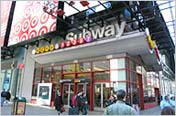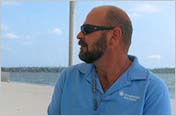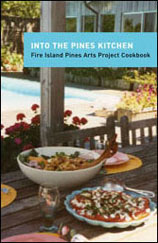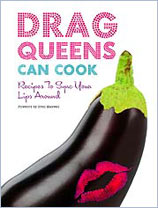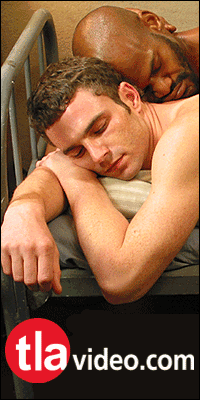|
|
photo by Bruce-Michael Gelbert
|
|
(left to right) Amaryllis Moleski, Tyler Matthew Oyer, Lucas de Lima, Bianca Rae Messinger, Rachel Higgins, KC Maddux, Amelia Bande, Ahimsa Timoteo Bodhrán, studio manager Jesse Harrod & (below) Director Chris Bogia
|
| ....................................................................................................................................................................................... |
The ninth annual Fire Island Artist Residency (FIAR), the first specifically LGBTQ artist residency in the world, has begun. FIAR Founding Director Chris Bogia and Studio Manager Jesse Harrod introduced the new residents, five visual artists and the three inaugural resident poets, on July 16 and 17 at the Cherry Grove Community House. The following listing represents the order in which those of us present met them.
Amaryllis Moleski, from New Haven, Connecticut, calls herself a storyteller of the most basic stories—origin and creation stories and myths—and envisions a queer genesis story. She does drawings on scrolls as spiritual texts and takes images considered “femme or foolish” and uses them significantly, ritually in her art. She uses refracted light as color in her installations and rainbows and constellations figure into her work. She showed her video of a boxer sparring with a rainbow figure of light.
Bianca Rae Messinger, from Iowa City, Iowa, calls herself a poet and translator and is concerned with Feeling and Time. She offers a lecture/play/poem about the relationship between time and feeling from a lesbian and transsexual perspective. She drew on Emily Brontë’s “Wuthering Heights” and the classic film of it, with Merle Oberon as Cathy and Laurence Olivier as Heathcliff, and asserted that they could only have a relationship freely after death, as “ghosts.”
KC Maddux, from Brooklyn, New York, is a trans visual artist, “assigned female at birth,” who transitioned at age 30. He uses photos of himself on a cut-out background, eschewing the traditional rectangular frame, in his eight-foot-by-four-foot works, which also suggests sculpture. KC declared, “Being a man is not a biological occurrence, but a cultural phenomenon.” “I like bright, playful colors,” he said of a slightly smaller—seven foot—work in yellow.
These first three artists expressed excitement about being able to work near the ocean.
Tyler Matthew Oyer is from Los Angeles, California. “Queer Body” is his work for performance space. “Historical specificity, social critique, radical action” mark his “Brechtian/Marxian dialectic.” He shared his work “Calling All Divas,” about our queer icons, and pointed out the lack of mentors for young artists because of the many deaths early in the AIDS crisis. In his work, Tyler references such heroes as Federico García Lorca, Charles Ludlam, Jack Smith, and Ron Vawter, as well as a villain like Roy Cohn.
Rachel Higgins has lived in Los Angeles for the past three years, in New York for 10 years, and before that, in Birmingham, Alabama. She is a sculptor, performer, and construction worker and points out how her identities as artist, builder, activist, and organizer inform each other. In Birmingham, she worked in a mostly abandoned shopping mall, which she said represented “Capitalism that refused to dies,” a “living dead,” “zombie” space. She and her friends, artists from Birmingham and New York City, rented a storefront in it for two weeks during the Christmas shopping season and turned it into a performance and installation space. With her building partner, she built a mostly wooden home on some available land in L.A. While here, she plans to investigate houses in the Pines that were built by a gay architect in the 1960s and ’70s.
Ahimsa Timoteo Bodhrán, originally from the South Bronx, now lives in Tulsa, Oklahoma. His multimedia work involves visuals, sounds, photographs, and text. Identifying as multi-racial, his first name is Moroccan and his Native American grandfather was one of the “skywalkers,” who worked on the Chrysler Building. He showed clips of some of the performances he’s been involved with.
Amelia Bande, from Brooklyn, New York, was born in New York and went with her family to Santiago, Chile when they returned there. She formed an a cappella singing group, in Chile in 1999, during the time of the dictatorship, and sang in English, Spanish, and “languages in between.” She showed a photo of herself publicizing her play “Troika” at Santiago’s Gay Pride, wearing a Spice Girls hat, and a clip of improvising a song out of discarded pages from a play script.
Lucas de Lima, from Philadelphia, Pennsylvania, originally comes from Brazil. He wrote a book about his friend Ana Maria, killed by an alligator, written from the viewpoints of his friend, himself, and the alligator. He mentioned that scientists worked with alligator blood, while developing Truvada. Pointing out that alligators and birds both had dinosaur ancestors, he also wrote a book considering a chicken. He plans to work on his third book, “Cosmic Bottom,” while he is here.
On July 17, FIAR and the Arts Project of Cherry Grove presented Hugh Ryan, author of “When Brooklyn Was Queer,” reading passages from his book and answering questions. He found that his was the “first ever queer history of Brooklyn,” though he had expected there would have been earlier books on the subject. In the 1920s and ’30s, Brooklyn, he found, was considered a gay destination, much as the Village and Harlem were.
Hugh began his reading with a passage about 7 Middagh Street (also known as February House), in Brooklyn Heights, where, for a short time, the likes of W.H Auden, Carson McCullers, and Gypsy Rose Lee lived. On Thanksgiving night, when Auden was entertaining members of the Russian Ballet, McCullers and Lee were out walking together. Very shortly, the household would break up and the house would be demolished.
Hugh read to us of his interview with Stonewall veteran Martin Boyce, who said that living in Brooklyn helped make him an “urban guerrilla” and said of the Stonewall Rebellion, “It was amazing!”
Hugh focuses on the period 1855 to 1966, from Walt Whitman’s time until the shuttering of the Brooklyn Navy Yard, and wrote, “Brooklyn was the only rival to Manhattan in hipness. Brooklyn boys had the edge.” He asked Boyce if Coney Island “could be labeled definitively queer,” and Boyce told him, no, going there was courting danger. But, “there was a scene going on on the Brooklyn Heights Promenade.” In the Heights, there was also the St. George Hotel, where Hart Crane once cruised, and its pool’s lifeguards were available.
Hugh wrote, “gay life flourished when there were jobs that gay people could have.” During World War Two, lesbians worked in factories and gay men went into the service. Gay men also cruised the waterfront.
“Coney Island, where pleasure reigned supreme,” and where there were amusement parks Luna Park and Steeplechase, was called “the nickel empire,” referring to the cost of a subway ride, and the shows there provided “a world of opportunity that men and women of different classes could enjoy together.” There, black lesbian performer Mabel Hampton, who was later interviewed extensively by the founders of the Lesbian Herstory Archives, found work, dancing in a sideshow. She was invited to a party given by Madame Walker, who made her fortune on skin and hair products for black women, and there she met the older woman who would bring her out, the first person from whom she heard the word “lesbian.” In this world, Hampton settled into “the role of stud,” roughly equivalent to the butch in a butch-femme relationship. “I had so many different girlfriends, it wasn’t funny!” Hampton said. Eventually, she was arrested and sent to the reformatory in Bedford Hills, New York, where they tried—in vain—to change her and prepare her for life as a servant or a wife.
Hugh also talked about drag king entertainers in Coney Island in the 1890s and the 1913 police raid on a bar at 32 Sands Street, where gay men came to meet sailors, and wound up charged with disorderly conduct.
Hugh Ryan’s next project will concern the old Women’s House of Detention, down the block from Stonewall, on Greenwich Avenue, where the community garden outside the Jefferson Market Library is now.
|









